 |
| Reopening in the Burnt Ruins |
| With school registration lists consumed by fire and school buildings devastated, staff and concerned neighbors urgently set about bringing their schools back into operation. When the war ended on August 15, 1945, the mobilized students were released from their duties. Reopened schools lacked proper buildings and teaching materials. Staff scavenged boards, darkened them with charcoal, and used stones to pound charred nails into them for makeshift blackboards. They lined up charcoal boxes to serve as desks. Despite formidable obstacles, the first steps toward recovery were taken. |
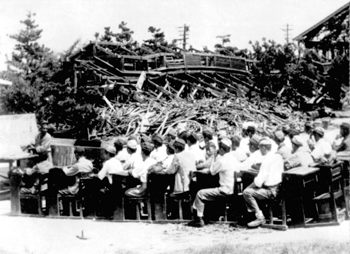 66/Open-air classrooms 1945 Hiroshima Prefectural Industrial School (Senda-machi) Courtesy of Hiroshima Prefectural Techinical High School Alumni Association |
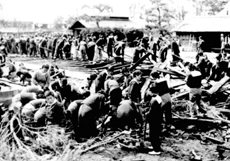 65/Students clearing away a collapsed building 1945-1946 Ruins of engineer unit barracks (Hakushima-kita-machi) Courtesy of Yasuda Educational Foundation Students contributed most of the labor to clear away the debris of the collapsed buildings so they could be rebuilt. Sometimes, these tasks would uncover a corpse. The photo shows students of Yasuda Girls' High School clearing away the ruins of the engineering unit barracks that had been converted into their school building. |
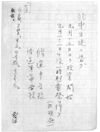 Courtesy of Shudo Junior and Senior High School This draft of a leaflet was found in the pages of a record of student information of Shudo Junior High School. In the upper left are names of neighborhoods: Hakushima, Koi, Ujina, Miyuki Bridge, Government Monopoly Bureau. It is thought that the leaflet was distributed in these areas. The leaflet announces the resumption of school on September 15 and the date of a scheduled memorial ceremony. |
 |
68/Newspaper announcement summoning students to the school
Chugoku Shimbun dated September 12, 1945 Courtesy of Chugoku Shimbunsha Yamanaka Girls' High School, Hiroshima Prefectural Industrial School and Hijiyama Girls' High School placed announcements in Chugoku Shimbun summoning students to assemble at the school. The Yamanaka Girls' High School building had been burned to the ground, so the students were asked to gather in the scorched schoolyard. Students and families had dispersed to various places of refuge. Lacking a means of contacting them, the school relied on word of mouth, newspaper announcement, and posters to inform the students that classes were starting up again. |
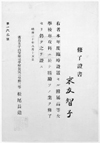 69/Certificate of course completion Courtesy of the Committee to Remember the Dead of Yamanaka Girls' High School attached to Hiroshima Women's Higher School of Education This certificate of course completion from Yamanaka Girls' High School dated August 15 was handed to the students at a completion ceremony on December 2. With the end of mobilization, the major and minor courses that had been put in place to allow students to continue their mobilization tasks after graduation from secondary school were also terminated. |
||
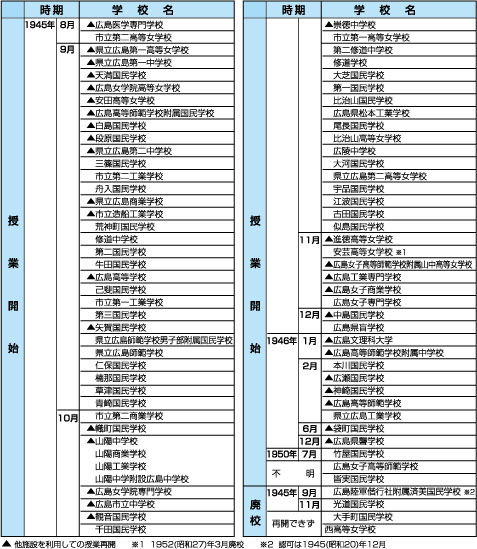 |
|||||
|
70/Resumption of Classes in Hiroshima City Schools.
Most schools reopened in September or October. The closer they stood to the city center, the more damaged the building and the more difficult the reopening. Schools that had totally lost their buildings managed to reopen by borrowing rooms in schools or other facilities left relatively intact. Some even conducted classes out doors. |
|||||
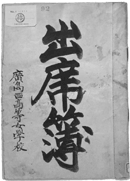
Entrusted by A-bomb Materials Preservation Association This is the roll book of the Higashi class, a class of fourth year of students mobilized to work in the Asahi Weapons Factory. Attendance at the mobilization site is recorded up to August 6. The 62 students who were in attendance at the factory were unharmed, but most of those who were out demolishing buildings were lost. The school itself, which burned to the ground, was never rebuilt or reopened. The brown spot on the roll book cover is a bloodstain from the injured teacher who accompanied the students. |
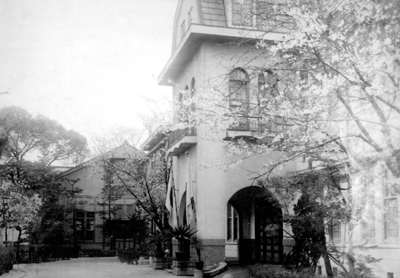 72/Where our school once stood Yamanaka Girls' High School (Senda-machi) Courtesy of the Committee to Remember the Dead of Yamanaka Girls' High School attached to Hiroshima Women's Higher School of Education "The school that we were enrolled in 40 years ago definitely existed. This is proven by many friends who studied together and inspired each other, were mobilized together, were injured together, and died together." (Taken from In Memorium) "If only the bomb hadn't fallen...." Was that not the thought that united all the graduates who lost their schools? |
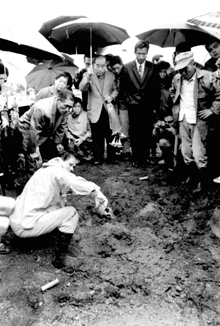 74/Discovery of remains on Ninoshima Island
October 29, 1971 Ninoshima Junior High training garden (Ninoshima-cho) Courtesy of Chugoku Shimbun Twenty-six years after the atomic bombing, the remains of 617 corpses were discovered at the Ninoshima Junior High training garden. Roughly 10,000 victims of the bombing were transported to Ninoshima Island, off Hiroshima's shore. Many of those who died were buried on the island. The belongings that were unearthed along with the remains were used to identify them. The remains of a student of Yamanaka Girls' High School exposed during building demolition were identified 26 years after her death and returned to her family. |
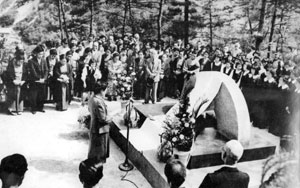 73/Monuments built May 1953 Ushita campus of Hiroshima Jogakuin (Ushita-higashi) Courtesy of Hiroshima Jogakuin Archives Before classes resumed, each school held memorial services and mourned their dead. As life became gradually easier, the wooden monuments erected by the families of the dead and persons related to the school were replaced by dignified stone monuments. The improved monuments did not diminish the suffering of the families. The photo shows the ceremony that marked the replacement of the temporary wooden monument with a stone monument at Hiroshima Jogakuin. |
|
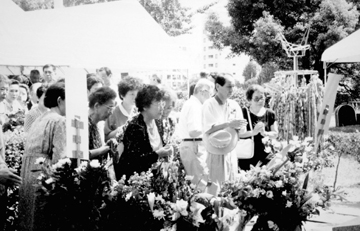 75/Inconsolable sorrow August 6, 2003 Green Zone on Peace Boulevard (Nakajima-cho) Courtesy of Hiroshima Municipal Funairi Girls' High School Alumni Association Even now, 59 years after the bombing, memorial services and ceremonies are held in front of the monuments built by various schools and at A-bombed sites. The grief of the families who lost their irreplaceable loved ones and their wrath at the atomic bomb continues unabated to this day. The photo shows the memorial service at First Municipal Girls' High School (now, Funairi High School), which lost 676 persons, of which 548 were demolishing buildings. This school lost more students and teachers to the bombing than any other school in the city. |
| Mobilized Students -The Lost Tomorrows of the Students- Introduction Schools Stained the Color of War The Start of Student Mobilization Building Demolition Amplified the Tragedy The Suffering of Mobilized Students Looking for Children Reopening in the Burnt Ruins Monuments to the Students Return to TOP |